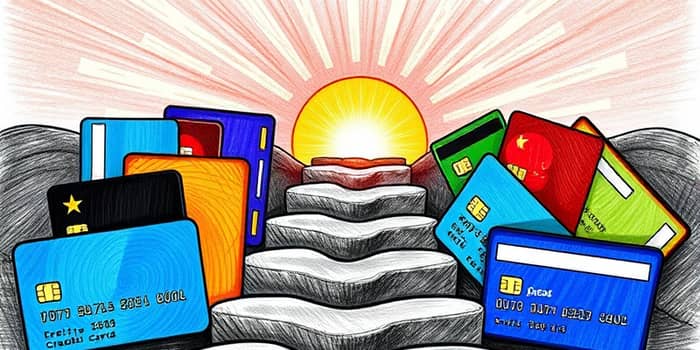
Managing multiple credit cards can feel like balancing plates on a tightrope. On one side, there’s the thrill of collectible points and exclusive perks; on the other, the looming risk of spiraling debt and missed deadlines.
Imagine Jane, who opened three cards to maximize your rewards effectively. At first, each statement arrived like a gift—bonus miles here, cashback there. But soon, the due dates blurred, interest piled up, and the excitement vanished into stress.
When managed well, multiple cards become powerful financial tools. They let you target specific spending categories, boost your credit profile, and enjoy extra security in emergencies.
Different issuers offer unique incentives—5% cashback on groceries, travel points for every dollar flown, or rotating category bonuses. By strategically using each card, you can build a robust credit profile over time.
Carrying multiple lines of credit can also keep individual card balances below 30%, helping you protect your financial future and boosting your overall score.
If one card is lost or compromised, you still have immediate alternatives—no frantic calls or frozen accounts delaying your daily life.
Yet every advantage carries a counterpart. Having more cards increases the chance of overspending, missing payments, and paying fees you never intended to incur.
When credit limits grow, so can impulsive purchases. Without a clear plan, you may avoid a debt spiral only to fall into one.
Keeping track of multiple due dates and promotional APRs can be overwhelming. Missed payments trigger late fees and damage your score, undermining the very benefits you sought.
Plus, each new application generates a hard inquiry, temporarily shaving points off your FICO score. Closing old accounts later can shorten your credit history, further affecting your rating.
Finally, every additional card is another potential entry point for fraud, so vigilance is key to stay ahead of fraudulent charges.
Your credit score hinges on several factors. By distributing balances and paying on time, you can tip the scales in your favor.
Keeping utilization low on each card reinforces a strong payment history, the single biggest factor in your score. When every statement is paid—and paid on time—you’re crafting a record of reliability.
Digital reminders and automatic payments ensure you prevent missed payments and fees. Pair these with a simple spreadsheet or budgeting app to monitor every transaction closely.
Regularly reviewing statements helps spot unauthorized charges early. Many issuers provide real-time fraud alerts, giving you peace of mind and control.
Know each card’s APR, annual fee schedule, and rewards expiration. If a card no longer aligns with your spending habits, consider downgrading or closing it strategically.
Finally, allocate a fixed portion of your monthly budget to pay balances in full or as much as possible. This step will help you avoid a debt spiral and maintain healthy finances.
Not everyone benefits from a wallet full of plastic. Ask yourself if you’re organized, disciplined, and proactive in reviewing your credit activity.
Good candidates are those who enjoy optimizing rewards, set aside financial planning time, and stay enthusiastic about checking statements. If you love fine-tuning your strategy and thrive on structure, multiple cards can be a boon.
However, if tracking dates feels like a chore, or if you’ve struggled with credit in the past, simplify. One or two cards, used wisely, often beats a dozen you can’t fully control.
Before applying for another plastic line, ensure you’re confident in your ability to manage each account’s spending, payments, and security.
Take these actions today:
By following these steps, you can harness the full power of multiple credit cards without falling prey to hidden pitfalls. With consistent habits and clear goals, you’ll turn potential chaos into a pathway for financial growth.
With more credit cards comes more responsibility—to keep payment due dates straight, to keep debt manageable and to continually assess whether the rewards justify the fees.
References













